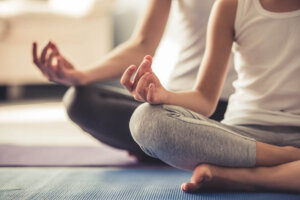How to Practice Micromeditation

Finding the time to include relaxing activities throughout the day can be tricky. Most of the time, it takes at least an hour, and the schedules and responsibilities of adult life can make it difficult to get into the habit. In these cases, there are functional alternatives to avoid turning your back completely on these activities. For example, you can practice micromeditation.
If you’re a fan of meditation, surely you’ve heard this term at some time. It’s relatively new, and it was born as a way to adapt this practice to busy schedules. With its help, you have no excuses for not adding relaxing activities to your daily life, and today we’ve taken on the task of teaching you 7 tips for practicing micromeditation.
What is micromeditation?
Micromeditation is nothing more than practicing meditation for a shorter period of time. Normally, conventional meditation sessions range from 20 to 50 minutes.
For many people, this can be difficult, as not everyone has the time required in their busy schedule. This is further reinforced by how long it takes to prepare for the session itself and what follows afterward.
It’s a recently popularized alternative whose objective is to practice meditation in shorter sessions. There’s no minimum time, although a general recommendation is that sessions last at least 30 seconds. Yes, you read that right! Micromeditation consists of activities that range from 30 seconds to 10 minutes.
For practitioners versed in meditation, these times can be derisory, but the truth is that for beginners who don’t have much time in their day, it can imply a change in their lives. The evidence indicates that meditation is related to multiple benefits on a physical and mental level. Here are some of the most important:
- Stress reduction
- Decreased anxiety
- Control of the symptoms of depression
- Reduced perception of pain (both physical and psychological)
- Stabilized blood pressure
- Regulated heart rate
- Controlled production of cortisol, epinephrine, and lactate
- Improved breathing rate
- Increases melatonin levels.
- Improved night rest patterns
- Increased blood flow to the brain region
- Increase in the subjective perception of happiness and general well-being
You can benefit from all of this if you practice micromeditation, and best of all, you can do it anytime, anywhere. It’s also a practice that you can include several times a day, even as a method to deal with specific emotional disturbances. There’s nothing to stop you if you want to practice micromeditation, although it’s good to know some basic guidelines.
7 tips to practice micromeditation
Broadly speaking, practicing micromeditation is the same as practicing conventional meditation. However, the fact that you have little time leads you to focus on certain particular details. We’ll leave you with 7 tips and some reflections on how to promote this practice.
1. Choose a personal mantra
As with conventional meditation, practicing micromeditation can be done hand in hand with mantras. Although you can choose ancient mantras, we recommend choosing personal phrases or sentences. This way, you manage to connect more closely and intimately with the words, and you adjust the meditation to what you want to achieve right at that moment.
Some experts have associated the use of mantras in meditation with positive improvements in mental health. They increase your concentration toward a goal, regulate your emotions, and keep you from losing control of a situation. Some examples of a personal mantra are “I can,” “I’m fine,” “I’m in control,” and “Progress, not perfection.” Pick just a handful of words and have several to use according to the occasion.
2. Focus on your breathing

If you’re short on time, you should focus on the biggest meditation enhancer: The cadence of your inhalations and breaths. Evidence has linked breath control to psychological and emotional well-being. It’ll take you several sessions to find the pattern that suits you the most, but the important thing is that the practice revolves substantially around how to breathe.
Make sure that the inhalations and exhalations are slow and deep, and if possible, try to do them through the nose. Close your eyes and keep your body still so you can feel your lungs fill and empty with air. As the sessions go by, try breathing variations, such as alternating through the mouth and nose or lengthening or reducing the cadence.
3. Find a comfortable place
We’ve already established that you can practice this habit anytime and anywhere. This means you won’t always have a comfortable place nearby, although this doesn’t imply that you should choose precisely the most uncomfortable place to practice micromeditation. A quick adjustment can make you completely change where you are, resulting in less muscle tension and more privacy when executing the habit.
For example, if you’re right at the office desk, you can move the chair back a little to have more space, slightly tilt the backrest, or use a cushion for support. If you’re in the middle of a group of people, you can move away from them a bit so that you can focus on the practice. In very simple terms, try to make your discomfort comfortable; that way, you’ll see that any place is the place to practice micromeditation.
4. Focus on the present
This is what’s known as full attention or mindfulness. It consists of focusing on what’s happening at the moment, so you focus on the here and now. You don’t need to dedicate the entire session to mindfulness, but it’s essential that you do so in the final minutes or seconds. With this, you manage to channel your emotional and cognitive stability to the situation that you’re going to find yourself in when you open your eyes.
5. Use background music
A quick search on Spotify will allow you to find hundreds and hundreds of playlists designed to meditate. Ideally, you should listen to the music with speakers, although if that isn’t possible, you can always use headphones. Music will allow you to balance the rhythm of your breathing and it will also mediate your mental isolation, concentration, and well-being.
6. Don’t focus on wandering thoughts

There are many misconceptions surrounding meditation. The most common of these is thinking that you simply remain blank-minded all the time. This isn’t so. In fact, it’s very common for wandering thoughts to arise.
That is, concerns or ideas that invade you and try to banish the ideas that you try to implement through your mantra. Don’t focus on them, but remember that their occurrence is very common.
7. Avoid judging the first sessions
A common mistake when practicing micromeditation is to judge it right after you finish. That is, grant it the seal of good or bad depending on the perceived improvements. Keep in mind that, as the sessions are much shorter, the benefits take a little longer to manifest. Also, the body needs to get used to this new habit, so you can in no way assess its impact during the first few sessions.
On the contrary, we invite you to make an assessment after several weeks; this way, you’ll be able to judge more objectively how good it has been to practice micromeditation. We promise that with the help of these simple steps, you’ll receive the aforementioned benefits, and all this without disturbing your daily commitments. Remember that allocating space for your mental and emotional health isn’t spoiling yourself–it’s a necessity.
Finding the time to include relaxing activities throughout the day can be tricky. Most of the time, it takes at least an hour, and the schedules and responsibilities of adult life can make it difficult to get into the habit. In these cases, there are functional alternatives to avoid turning your back completely on these activities. For example, you can practice micromeditation.
If you’re a fan of meditation, surely you’ve heard this term at some time. It’s relatively new, and it was born as a way to adapt this practice to busy schedules. With its help, you have no excuses for not adding relaxing activities to your daily life, and today we’ve taken on the task of teaching you 7 tips for practicing micromeditation.
What is micromeditation?
Micromeditation is nothing more than practicing meditation for a shorter period of time. Normally, conventional meditation sessions range from 20 to 50 minutes.
For many people, this can be difficult, as not everyone has the time required in their busy schedule. This is further reinforced by how long it takes to prepare for the session itself and what follows afterward.
It’s a recently popularized alternative whose objective is to practice meditation in shorter sessions. There’s no minimum time, although a general recommendation is that sessions last at least 30 seconds. Yes, you read that right! Micromeditation consists of activities that range from 30 seconds to 10 minutes.
For practitioners versed in meditation, these times can be derisory, but the truth is that for beginners who don’t have much time in their day, it can imply a change in their lives. The evidence indicates that meditation is related to multiple benefits on a physical and mental level. Here are some of the most important:
- Stress reduction
- Decreased anxiety
- Control of the symptoms of depression
- Reduced perception of pain (both physical and psychological)
- Stabilized blood pressure
- Regulated heart rate
- Controlled production of cortisol, epinephrine, and lactate
- Improved breathing rate
- Increases melatonin levels.
- Improved night rest patterns
- Increased blood flow to the brain region
- Increase in the subjective perception of happiness and general well-being
You can benefit from all of this if you practice micromeditation, and best of all, you can do it anytime, anywhere. It’s also a practice that you can include several times a day, even as a method to deal with specific emotional disturbances. There’s nothing to stop you if you want to practice micromeditation, although it’s good to know some basic guidelines.
7 tips to practice micromeditation
Broadly speaking, practicing micromeditation is the same as practicing conventional meditation. However, the fact that you have little time leads you to focus on certain particular details. We’ll leave you with 7 tips and some reflections on how to promote this practice.
1. Choose a personal mantra
As with conventional meditation, practicing micromeditation can be done hand in hand with mantras. Although you can choose ancient mantras, we recommend choosing personal phrases or sentences. This way, you manage to connect more closely and intimately with the words, and you adjust the meditation to what you want to achieve right at that moment.
Some experts have associated the use of mantras in meditation with positive improvements in mental health. They increase your concentration toward a goal, regulate your emotions, and keep you from losing control of a situation. Some examples of a personal mantra are “I can,” “I’m fine,” “I’m in control,” and “Progress, not perfection.” Pick just a handful of words and have several to use according to the occasion.
2. Focus on your breathing

If you’re short on time, you should focus on the biggest meditation enhancer: The cadence of your inhalations and breaths. Evidence has linked breath control to psychological and emotional well-being. It’ll take you several sessions to find the pattern that suits you the most, but the important thing is that the practice revolves substantially around how to breathe.
Make sure that the inhalations and exhalations are slow and deep, and if possible, try to do them through the nose. Close your eyes and keep your body still so you can feel your lungs fill and empty with air. As the sessions go by, try breathing variations, such as alternating through the mouth and nose or lengthening or reducing the cadence.
3. Find a comfortable place
We’ve already established that you can practice this habit anytime and anywhere. This means you won’t always have a comfortable place nearby, although this doesn’t imply that you should choose precisely the most uncomfortable place to practice micromeditation. A quick adjustment can make you completely change where you are, resulting in less muscle tension and more privacy when executing the habit.
For example, if you’re right at the office desk, you can move the chair back a little to have more space, slightly tilt the backrest, or use a cushion for support. If you’re in the middle of a group of people, you can move away from them a bit so that you can focus on the practice. In very simple terms, try to make your discomfort comfortable; that way, you’ll see that any place is the place to practice micromeditation.
4. Focus on the present
This is what’s known as full attention or mindfulness. It consists of focusing on what’s happening at the moment, so you focus on the here and now. You don’t need to dedicate the entire session to mindfulness, but it’s essential that you do so in the final minutes or seconds. With this, you manage to channel your emotional and cognitive stability to the situation that you’re going to find yourself in when you open your eyes.
5. Use background music
A quick search on Spotify will allow you to find hundreds and hundreds of playlists designed to meditate. Ideally, you should listen to the music with speakers, although if that isn’t possible, you can always use headphones. Music will allow you to balance the rhythm of your breathing and it will also mediate your mental isolation, concentration, and well-being.
6. Don’t focus on wandering thoughts

There are many misconceptions surrounding meditation. The most common of these is thinking that you simply remain blank-minded all the time. This isn’t so. In fact, it’s very common for wandering thoughts to arise.
That is, concerns or ideas that invade you and try to banish the ideas that you try to implement through your mantra. Don’t focus on them, but remember that their occurrence is very common.
7. Avoid judging the first sessions
A common mistake when practicing micromeditation is to judge it right after you finish. That is, grant it the seal of good or bad depending on the perceived improvements. Keep in mind that, as the sessions are much shorter, the benefits take a little longer to manifest. Also, the body needs to get used to this new habit, so you can in no way assess its impact during the first few sessions.
On the contrary, we invite you to make an assessment after several weeks; this way, you’ll be able to judge more objectively how good it has been to practice micromeditation. We promise that with the help of these simple steps, you’ll receive the aforementioned benefits, and all this without disturbing your daily commitments. Remember that allocating space for your mental and emotional health isn’t spoiling yourself–it’s a necessity.
- Álvarez-Pérez Y, Rivero-Santana A, Perestelo-Pérez L, et al. Effectiveness of Mantra-Based Meditation on Mental Health: A Systematic Review and Meta-Analysis. Int J Environ Res Public Health. 2022;19(6):3380. Published 2022 Mar 13.
- Sharma H. Meditation: Process and effects. Ayu. 2015;36(3):233-237.
- Zaccaro A, Piarulli A, Laurino M, et al. How Breath-Control Can Change Your Life: A Systematic Review on Psycho-Physiological Correlates of Slow Breathing. Front Hum Neurosci. 2018;12:353.
Este texto se ofrece únicamente con propósitos informativos y no reemplaza la consulta con un profesional. Ante dudas, consulta a tu especialista.







